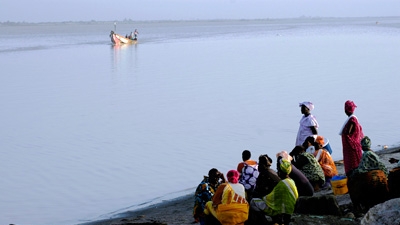DAKAR, April 3, 2013—In Senegal, near the village of Sadel, five hours of rough road northeast of Dakar, the markets that line the Senegal river are anything but deserted. Thanks to improved irrigation, local communities like this one are able to sell watermelons, squash, tomatoes, and even rice and the waters surrounding the area are flush with Senegal River Perch. Residents earn their livelihoods almost entirely utilizing river resources. The health of the Senegal River is crucial to their prosperity.
In 2006, the World Bank launched the US$110 million Senegal River Basin Multi-Purpose Water Resources Development project (MWRD), a regional, multi-sector investment program addressing fisheries, irrigation, health, and water resources management in Guinea, Mali, Mauritania and Senegal. The project works closely with the Senegal River Basin Organization (OMVS), established in 1972 by Mali, Mauritania and Senegal to improve the use of and access to water across national boundaries.
By some estimates, fish stocks in the Senegal River are up nearly 13% since the start of the project and there are clear indications from residents in riverside villages like Sadel that both the size and quantity of the catch have significantly improved.
“Now there are more fish to feed us and increased incomes,” says one lifetime resident as he holds up a two-foot-long perch.
In addition, nearly 4,400 acres of land has been rehabilitated for agricultural use through irrigation and water management, meaning residents can plant at least two seasons during the year. The increased cultivation opportunities have particularly impacted women, many of whom are heads of households and rely on subsistence agriculture to support their families.
Migrants are coming home
For the 12 million residents of the Senegal River basin, an area that covers more than 1% of Africa’s land mass, water is a vital part of their livelihoods. During the seven months of the dry season, rainfall averages only .1 inches (2.5 mm) per month, and daily temperatures can reach over 100 degrees Fahrenheit (37 degrees Celsius). Not only are fish from the river a source of food, but the annual floods during the rainy season are crucial for replenishing the nutrients that sustain pasture land and for irrigating crops. Without access to water, grass for grazing becomes scarce and only a few crops grow in the harsh climate.
Thirty years ago, the Senegal River supported one of the largest freshwater fisheries in Africa. Over time, overfishing and riverside development put pressure on the fisheries, leading to a near-collapse of the industry. In a practical demonstration of development tradeoffs, while dams helped in bringing critical power and telecommunications capabilities to the region, they also interrupted the annual cycle of river flooding depriving many farmers of access to water necessary to grow crops.
According to local sources, thanks to the uptick in fishing, the river basin is for the first time seeing a return of migrants who left their villages for the main city of Dakar over a decade ago. With increased opportunities along the river, these former migrants are now able to earn a living in the towns and villages that line the Senegal River, back among the fish, fields and family they had once made the difficult choice to leave behind.
And, more recent holistic efforts to combine support for sustainable fishing and improved access to markets with more traditional water resources development activities such as energy and agriculture are beginning to make a difference for the residents of villages like Sadel.
“The river basin approach offers many more opportunities to develop infrastructure with multiplier impacts - for agriculture, water supply, energy, and navigation, as well as health - than a single operation,” says Shelley McMillian, a water resources specialist at the World Bank and the team leader for this project.
According to McMillian, when countries jointly manage shared water resources, there are significant benefits that emerge beyond the water sector in terms of poverty reduction, low carbon growth, regional trade, and stability.
“The Multi-Purpose Water Resources Development project is a truly transformational project,” according to Colin Bruce, Director for Strategy, Operations, Regional Integration and Partnerships in the World Bank’s Africa Region. “It illustrates some of the practical results that we are achieving through the Regional Integration program—multi-country, cross border solutions that make a long-term dent on poverty.”
With the first phase of the project closing in spring 2013, MWRD is already delivering remarkable results. The second phase is currently under preparation and expected to be presented to the Board in July 2013.
One major accomplishment of the project so far has been the formal inclusion of Guinea into the Senegal River Basin Organization, which previously included only Mali, Mauritania and Senegal. All four countries are now working together through the regional body to manage water resources. This is only the second time the Bank has brokered such an agreement on international waters (the first time being the 1960 Indus Waters Treaty).
Perhaps the most compelling result, according to Mohammed Salem Ould Merzoug, High Commissioner of OMVS, has been in the improvement of local health. Malaria and the parasitic schistosomiasis, also known as bilharzia or snail fever, have been particularly problematic in the basin, impacting residents’ ability to work and attend school and increasing maternal and child mortality.
Prevention and control activities through the project for malaria and schistosomiasis in the form of bed nets and anti-parasitic treatments have dramatically reduced the prevalence of both debilitating illnesses. Currently, 83% of children under five in the project area now sleep under a mosquito net, drastically reducing malaria rates for this vulnerable population. In some areas, the distribution of regular medication has nearly eliminated schistosomiasis altogether.
“I take particular satisfaction from our social investment in the basin,” says the High Commissioner of the OMVS. “Thanks to [MWRD] we have made tangible progress on the frontiers of the triple human tragedy of mass poverty, disease and hunger.”

